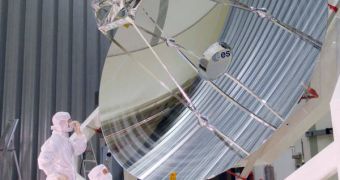After being successfully launched in May, together with the Planck Space Telescope, the billion-euro Herschel has finally ejected the cover protecting its delicate instruments from radiation, as it nears the final destination of its 1.5 million kilometers to the L2 point in orbit. Yesterday, mission controllers sent a crucial command to the spacecraft, detonating two explosive charges that pushed the lid away, allowing the supercold chamber holding the observatory's instruments to be flooded with light for the first time. The successful stage marks the beginning of months of calibrations, before Herschel begins its scientific mission.
The telescope sports a giant 3.5-meter mirror, which astronomers hope to use to analyze how galaxies appear and form, and also how they evolved from the early Universe up to this point. Its supercold instrument chamber, known as the cryostat, is able to pick up very faint readings, and the liquid helium inside allows for all of the three main instruments to be maintained at a temperature close to absolute zero (-273 degrees Celsius, 0 degrees Kelvin). The European Space Agency (ESA) launched the two satellites on an Ariane 5 delivery system, on May 14th, from the Kourou Space Center, in South America.
“We need the lid open or we can't see the sky, so it's a really important event,” the principal investigator for one of Herschel's instruments, the SPIRE, Professor Matt Griffin, explained, quoted by the BBC News. This stage of the mission couldn't have come at a better time, the expert said, because the Paris Air Show was about to open. During the event, space agencies from around the world will get together and celebrate their achievements. For ESA, this would be another opportunity to restate its position as an emerging “power” in the industry, capable of high-tech missions.
According to mission engineers, the instruments on Herschel have been locked inside the cryostat for well over two years now, and only a month into the flight was it considered prudent to blow up the lid and allow light in. “Anything that's launched into space always has some water vapor and various other contaminants – volatile gases – absorbed in its materials; and in space the water and these volatiles slowly boil away into the vacuum of space. It is conventional and necessary to wait for this to happen, to make sure these contaminants don't find their way inside the cryostat where they could condense in the instruments,” Griffin, who is a professor at the Cardiff University, added.

 14 DAY TRIAL //
14 DAY TRIAL //